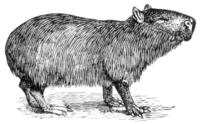Capybara
|
|
| Capybara Conservation status: Lower risk | ||||||||||||||||
|---|---|---|---|---|---|---|---|---|---|---|---|---|---|---|---|---|
 | ||||||||||||||||
| Scientific classification | ||||||||||||||||
| ||||||||||||||||
| Binomial name | ||||||||||||||||
| Hydrochoerus hydrochaeris (Linnaeus, 1766) |
The capybara (Hydrochoerus hydrochaeris) is the largest of living rodents (the long extinct rodent Phoberomys pattersoni was significantly bigger.) They are native to most of the tropical and temperate parts of South America east of the Andes, always near water. It is the only living member of its family, Hydrochoeridae. It is called carpincho in Spanish and capivara in Portuguese, although the name originally derives from the Guarani "Kapiÿva".
Description and habits
Ph-animals-capybara-2.jpg
Full-grown capybaras reach between 105 and 135 cm in length, and weigh 35 to 65 kg. Capybaras are excellent swimmers, and have partially webbed feet. They mate in the water, use the water to hide from predators, and can stay submerged for several minutes. Capybaras can even sleep underwater, with only the nose exposed.
Capybaras are herd animals. The males of the species have a gland on their nose, which exudes a sort of liquid. In the mating season, they will rub this on the surrounding foliage to attract females. They spend most of their time on the banks of rivers, feeding in the mornings and evenings. The diet consists of vegetation such as river plants and bark.
Economical and ecological aspects
In the regions along the Paraná river in Southern Brazil, Northern Argentina, and Uruguay, capybaras are frequently captured and kept as pets, or occasionally hunted for food. The flesh is described as tasting like swine and has a whitish appearance similar to pork.
Venezuelan farmers who once considered the animal a pest now make a valuable addition to their incomes by selling capybara meat (approximately 400 metric tons annually). The rodents are rounded up in February so that they can be slaughtered and sold just before the onset of Lent, when the meat is in high demand. This popular custom is attributed to a curious theological decision by the Catholic Church that classifies Capybara as fish.
When European missionaries first met capybaras in South America during the 16th century, they wrote to Rome for guidance, saying "there is an animal here that is scaly but also hairy, and spends time in the water but occasionally comes on land; can we classify it as a fish?" The question was significant, as the Catholic faith forbides eating meat (other than fish) during Lent, the period of abstinence lasting 40 days before Easter. Having a second-hand description of the animal, and not wanting the petitioners to turn away from Catholicism, the Church agreed and declared the capybara a fish — a decision that was never reversed.
See also
de:Wasserschwein es:Capibara fr:Capybara it:Hydrochoerus hydrochaeris he:קפיבארה nl:Capybara pt:Capivara ru:Капибара sv:Capybara

